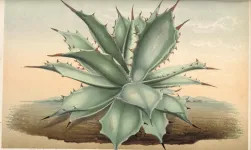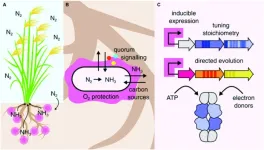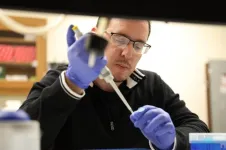(Press-News.org) Mezcal is a distilled alcohol made from the boiled and fermented sap of agave plants. Most mezcal beverages — including all brands of tequila — are sold as pure distillates, but a few have an added stowaway bottled inside: worms.
Called gusanos de maguey (Spanish for agave worms), these odd organic chasers aren’t actually worms, but instead a type of insect larva, and their addition to mezcal is a recent one. Mezcal production has a storied history, dating back to the first Spanish inhabitants of Mexico, but larvae were only added to the drink in the 1940s.
Since then, gusanos have helped boost the popularity of mezcal, but their identity has remained elusive. There’s no consensus on what type of larva is used in mezcal or even if it belongs to one or multiple species. They’ve been variously ascribed to moths, butterflies and even a type of weevil.
“It’s relatively easy to broadly determine the kind of larva based on the shape of the head, but their identity has never been confirmed,” said Akito Kawahara, curator at the Florida Museum’s McGuire Center for Lepidoptera and Biodiversity. “This is probably because most biologists are not looking inside mezcal bottles.”
In a new study, published today in the journal PeerJ Life & Environment, Kawahara and his colleagues decided to pin down the identity of the mezcal gusanos. In 2022, they traveled to Oaxaca Mexico, which has been the center of mezcal production for hundreds of years. There, they visited distilleries and obtained as many different brands as they could find to ensure a diverse sampling of larvae.
There were very few distinguishing features that could be used to assign the specimens to a particular group or species; fortunately, mezcal makes an excellent preservative, preventing the decay of the larvae and their internal packets of DNA. The researchers successfully extracted and analyzed genetic material from 18 specimens, but the results they got back were unexpected.
Since gusanos de maguey aren’t commercially farmed, the authors suspected that mezcal worms would likely be sourced from several unrelated species. This included a type of butterfly called the tequila giant skipper (Aegiale hesperiaris), which lays its eggs on agave plants. Their large, milky-white caterpillars parasitize several agave species, boring tunnels through the rigid, succulent leaves. The eponymous common name, combined with their white larvae — which matches the color of many gusanos de maguey — marked them out as a primary suspect.
Instead, the DNA unequivocally identified all 18 specimens as the caterpillars of agave redworm moths (Comadia redtenbacheri), another type of agave parasite with rosy-hued larvae. The researchers suspect that accounts of white gusanos de maguey come from caterpillars that have been stored in alcohol for long amounts of time and have consequently leached their color.
The results add a sobering note to what is currently a boom in the international popularity of mezcal. According to a report by Straits Research, an independent analytical firm, the sale of mezcal is expected to increase by 22% in the next decade, reaching $2.1 billion in profits by 2030, riding a growing wave of interest in artisanal, ethically manufactured products.
Unlike tequila, which is mass-produced in industrial autoclaves, mezcal production continues to rely on small-scale facilities in Mexico’s arid countryside. Farmers roast the barrel-shaped agave cores in open fire pits or specialized kilns, then chop and pulverize the crisp stumps for fermentation and small-batch distribution. It’s unclear whether all mezcal distilleries and landowners will be able to sustainably scale up production to meet demand.
The fate of agave redworm moths is also uncertain. Maguey worms have been harvested as a delicacy for centuries, beginning with the Aztecs. But demand for the larva in Mexican culinary establishments has also seen an increase in recent years, to the extent that wild populations of these caterpillars are considered at risk of overharvesting.
“Agave worms are still fairly common, but the impact of mezcal becoming popular can have long-term negative effects on local populations because they are harvested in the wild,” Kawahara said.
Red agave caterpillars burrow deep into the core of their hosts plants, and collecting them often kills the agave. For production to scale with the growing market, it’s possible local harvesters may need to actively grow caterpillars on agave farms or find ways to produce them outside of their host plants.
END
Scientists uncover the unexpected identity of mezcal worms
2023-03-08
ELSE PRESS RELEASES FROM THIS DATE:
AERA announces 2023 fellows
2023-03-08
WASHINGTON, March 8, 2023—The American Educational Research Association (AERA) has announced the selection of 24 exemplary scholars as 2023 AERA Fellows. The AERA Fellows Program honors scholars for their exceptional contributions to, and excellence in, education research. Nominated by their peers, the 2023 Fellows were selected by the Fellows Committee and approved by the AERA Council, the association’s elected governing body. They will be inducted during a ceremony at the 2023 Annual Meeting in Chicago on April 14. They join a total of 714 AERA Fellows.
“AERA Fellows demonstrate the highest standards ...
A better way to produce fertilizers
2023-03-08
Fertilizers are one of the main reasons that we are able to grow enough crops to feed the almost 8 billion humans living on Earth. Modern agriculture depends largely on nitrogen-based fertilizers, which significantly increase the yield of crops. Unfortunately, a great portion of these fertilizers are produced at an industrial level, consuming fossil fuel energy and causing nitrogen pollution.
One attractive way to minimize our use of industrially produced fertilizers is to harness the power of nitrogenases. ...
University of Cincinnati study finds little federal funding for incarceration-related research
2023-03-08
Research from the University of Cincinnati finds a lack of federal funding for incarceration-related research. The study looked at data from the Department of Justice, National Institutes of Health (NIH) and National Science Foundation, some of which dated back to 1985.
The study was published recently in the journal JAMA Network Open.
“We have very little evidence-based research on how and when to intervene with children and families when someone is removed from the home due to incarceration, especially on how to ...
How nanoplastics can influence metabolism
2023-03-08
PET, the plastic used to make bottles, for example, is ubiquitous in our natural environment. In a joint study, scientists from Leipzig University and the Helmholtz Centre for Environmental Research (UFZ) investigated the negative effects that tiny plastic PET particles can have on the metabolism and development of an organism. Their findings have now been published in the journal Scientific Reports.
The increasing use of plastic is threatening ecosystems around the world. One of the big concerns is the presence of plastics in the form of small particles, also called microplastics and nanoplastics. ...
Virginia Tech researchers study PTSD effects on bystanders
2023-03-08
The traditional line of thought is that post-traumatic stress disorder (PTSD) is caused by directly experiencing the traumatic event. However, about 10 percent of diagnosed PTSD occurs when people witness these events versus experiencing it directly themselves.
Little is known about these cases of PTSD, but that’s something that Tim Jarome, an associate professor in the College of Agriculture and Life Sciences School of Animal Sciences, is aiming to change with a $430,000 grant from the National Institute ...
New pain medications are still widely inaccessible to individuals living with sickle cell disease
2023-03-08
(WASHINGTON, March 8, 2023) – Sickle cell disease (SCD), a rare chronic, progressive, life-threatening, inherited blood disorder, often affects individuals with chronic pain that can be debilitating to their quality of life. Yet less than 4% of people living with SCD who experience chronic pain episodes have prescriptions for newer FDA-approved pain-relieving drugs, including l-glutamine, voxelotor, and crizanlizumab, according to a new study published in Blood Advances. Further, researchers found that less than a third of patients with pain episodes have prescriptions for hydroxyurea, ...
Two-pronged immunotherapy eliminates metastatic breast cancer in mice
2023-03-08
Metastatic breast cancer has no cure and has proven stubbornly resistant to one of the most innovative and promising new cancer treatments: immunotherapy.
Now, researchers at Washington University School of Medicine in St. Louis have identified a way to treat the area surrounding breast tumors that have spread to bone so that such tumors become vulnerable to attack by the body’s immune system. When the researchers boosted the activity of certain immune cells, called T cells and macrophages, these immune cells worked together to clear metastatic breast tumors that had spread to the bones of mice, and continued to eliminate tumor cells ...
Researchers take a step towards turning interactions that normally ruin quantum information into a way of protecting it
2023-03-08
Researchers have found a way to predict the behavior of many-body quantum systems coupled to their environment. The work represents a way to protect quantum information in quantum devices, which is crucial for real-world applications of quantum technology.
In a study published in Physical Review Letters, researchers at Aalto University in Finland and IAS Tsinghua University in China report a new way to predict how quantum systems, such as groups of particles, behave when they are connected to the external environment. ...
Long-term exposure to nitrate in drinking water may be a risk factor for prostate cancer
2023-03-08
The nitrate ingested over the course of a person’s adult lifetime through the consumption of tap water and bottled water could be a risk factor for prostate cancer, particularly in the case of aggressive tumours and in younger men. This is the conclusion of a study conducted in Spain and led by the Barcelona Institute for Global Health (ISGlobal), a centre supported by the ”la Caixa” Foundation. The findings have been published in Environmental Health Perspectives.
The study also suggests that diet plays an important role. The researchers found that eating plenty of fibre, fruit/vegetables and vitamin C could reduce the negative effect ...
UNIST receives generous gift from BNK Kyongnam Bank
2023-03-08
UNIST and BNK Kyongnam Bank recently held a donation agreement ceremony in pursuit of creating a beautiful, biodiverse, and sustainable kitchen garden on UNIST campus.
A ceremony to commemorate and display gratitude for BNK Kyongnam Bank also took place on Friday, February 24, 2023. As part of its Carbon Neutral Campus Project, UNIST has been implementing a number of projects to improve sustainability on campus and in the surrounding community, including the creation of an ecological garden that ...





